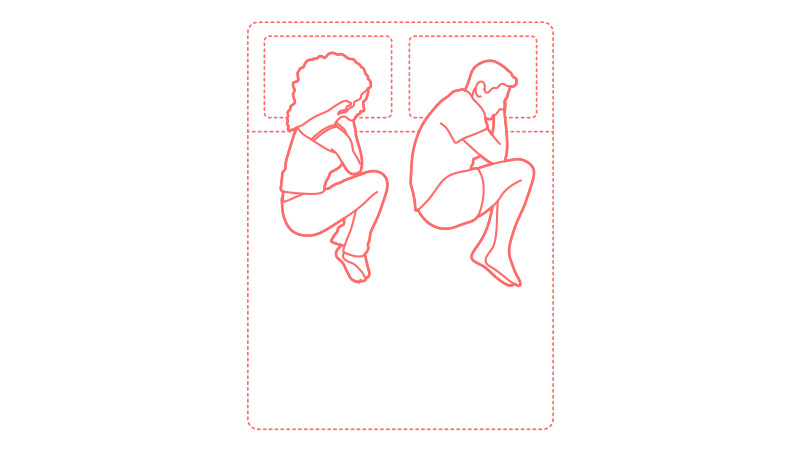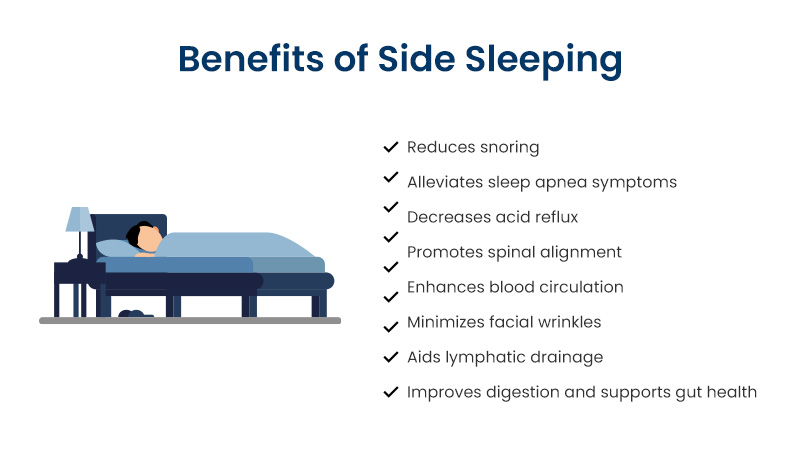Everyone needs a restful night’s sleep. Some achieve it, and some don’t. It can be tricky to get a sound sleep at night because of several disturbances, one of which can be the position you sleep in. You might have the best pillows, mattress, comforter, and everything you need, but if you sleep funny, you may wake up to pain and discomfort every morning.
Side sleeping is said to have multiple benefits for the human body. No wonder 63% of adults sleep on their sides. The best posture depends mainly on the structure of the human body. It all depends on which side you sleep on if you're a side sleeper.
Side sleeping is one of the healthiest sleep positions. It has several advantages, including better spinal alignment and a lower chance of heartburn, snoring, and back pain. After years of comfortably sleeping on your stomach or back, learning to sleep on your side may not be the best option. We've looked at a few pointers to ensure a seamless transition.
What are Side Sleeping and Side Sleepers?
Many individuals choose side sleeping as their preferred sleeping position owing to its numerous benefits in terms of physical and mental health benefits. Consequently, those who habitually sleep on their side are called side sleepers.
There are three primary positions to sleep in: on your side, on your back, or on your stomach. However, it's thought that grownups like to sleep on their sides the most. According to the National Sleep Foundation research, approximately 63% of Americans reported sleeping on their side.
Types of Side Sleeping Positions
One might take several postures when side sleeping, but it is undoubtedly more complex than it seems. Selecting the best sleeping position may enhance your sleep quality and general health because each has advantages and disadvantages.
1. The Fetal Position

There is a tell-tale sign about its name. One of the most common postures among side sleepers is lying in a fetus-like manner, whereby the sleeper curls sideways, drawing knees towards the chest. This position is known as the “fetal position” because it resembles the position of an unborn child inside a mother’s womb. It is helpful for those having back pain or tending to snore less while sleeping in it. Notwithstanding, for some individuals, compression of the diaphragm results in difficulty breathing while in this position.
2. The Log Position

Visualize how a log would appear—it resembles this stance exactly. Here, an individual lies on their side with both arms and legs stretched out. The log shape allows one to breathe through his/her mouth without ingesting any dust while diminishing the noise vibrations caused by an obstruction in breathing passages during sleep. Besides this, it can alleviate spinal issues and reduce aches along the lower back region, and you don’t feel any discomfort.
3. The Yearner Position

This position is similar to the Log position but with arms extended outwards. This posture also maintains open airways and reduces snoring. Due to the head's elevation, acid reflux is less likely. However, it can strain the shoulders, causing pain and discomfort in those areas.
4. The Prayer Position

People who suffer from neck problems often use the prayer method: lying on your side with your hands clasped as though praying. In addition, an individual can put their hands behind the neck or under the pillow in the same praying manner. Furthermore, this position helps lift one’s head, and one should consider replacing their pillows with new, firm ones.
5. The Pillow Snuggler Position

Embracing a pillow may be comforting and supportive when sleeping on the side. This posture eases shoulder and arm strain and helps realign the spine. It may also benefit those with heartburn or acid reflux.
Health Benefits of Side Sleeping
So what makes side sleeping so popular? Let's look at some potential benefits of this sleeping position.
1. Provides Optimal Back Support
Sleeping on your side is essential for comfort. When you sleep sideways, your body's weight is evenly spread, easing tension from your joints, especially your hips and shoulders. This can greatly benefit problems like arthritis or back pain.
In addition, sleeping on the side helps maintain proper spine alignment. When you sleep on the side, the spine's natural curvature is maintained, minimizing the chances of developing back strain or pain. Consequently, people with back problems may find it beneficial.
2. Improves Breathing and Digestion
Side sleeping can enhance breathing and digestion. Breathing becomes more straightforward when you lie on your side since there is less chance of airway obstruction. Those who suffer from sleep apnea or snoring may find this helpful. Furthermore, since sleeping on one's side relieves pressure on the stomach and enables it to rest naturally, it can help promote good digestion.
3. Reduces Acid Reflux
Side sleeping also reduces acid reflux due to its positioning. When lying on the side, the stomach and the esophagus are below the thorax, so stomach acid smoothly returns to the upper part of the body less often, which causes less heartburn. This leads to some other advantages for people suffering from GERD or having too much acidity in their stomachs.
4. Comforts During Pregnancy
It is strongly advised to sleep on your side during pregnancy to ensure adequate blood flow to the placenta and to improve circulation by avoiding strain on the inferior vena cava. Additionally, by maintaining the spine’s natural alignment, this posture helps you get rid of your back pain, lessens the strain on vital organs such as the liver and uterus, and enhances breathing by preventing the uterus from pressing on the diaphragm.
Side sleeping is the best pregnancy sleeping position for both the mother and the baby. Furthermore, sleeping on one's side—mainly the left—improves digestion by allowing stomach contents to pass more easily into the mouth, which also helps reduce acid reflux and heartburn.

Placing the best body pillow for side sleepers beneath your belly and between the knees can make it more comfortable while providing the necessary support for your expanding uterus.
5. Minimizes Sleep Apnea
When people sleep on their backs rather than their sides, they often snore more. Snoring might arise from an obstruction in the throat caused by the tongue falling back into the throat when one sleeps on one's back.
Breathing may be easier when you sleep on your side since your airway may remain more open. Because of this, doctors advise patients suffering from position-dependent sleep apnea, a severe breathing problem associated with sleep, to sleep on their side to reduce symptoms.
6. Improves Brain Health
Side sleeping may benefit brain health by increasing the effectiveness of the lymphatic system, which removes waste from the brain. This position—especially on the side of the nose that is not the dominant nostril—may help lower the risk of neurological diseases by eliminating toxins and metabolic waste.
Furthermore, side sleeping is associated with more profound, more restorative sleep, which is necessary for memory consolidation and cognitive performance.
Side sleeping enhances general brain health and may help reduce the chance of cognitive deterioration over time by fostering higher-quality sleep. For this reason, switching to a side sleeping posture may help preserve brain health and help them perform at their best.

Sleeping Tips for Side Sleepers
We need sleep for our physical and emotional health. However, it might be difficult for side sleepers to obtain a decent night's sleep. The posture alone may be uncomfortable, resulting in a restless night of rolling over and tossing. Here are some suggestions to help side sleepers having trouble getting a good night's sleep. Sometimes, you sleep fine but might have shoulder or neck pain when sleeping on the side.
1. Get a Good Mattress
The base of a comfortable night's sleep begins with your pillow and mattress. If you sleep on your side, you require a mattress that supports and aligns your spine correctly. To reduce pressure points on your shoulders and hips, look for a mattress with plenty of padding and medium-to-firm support.
Likewise, choose a pillow that maintains your head in alignment with your spine and supports your neck. For side sleepers, memory foam or contour pillows are the best options since they fit the contours of your head and offer the perfect amount of support.
2. Try to Keep your Neck Aligned
When you sleep on your side, your neck is particularly vulnerable, and improper support can cause stiffness and pain. To prevent this, ensure your pillow maintains your neck aligned with your spine.
Pick a pillow that can be adjusted in height or has a contoured design to support the natural curvature of your neck. Try putting a little pillow between your legs to maintain hip alignment and lessen strain on your lower back.
3. Maintain a Comfortable Posture
The fetal and log positions are the two primary sleeping postures for side sleepers. Those who sleep on their sides are more likely to adopt the fetal position, which involves curling up towards their chest. However, this position can also impede breathing and place undue strain on joints.
Conversely, sleeping in the log position—which involves keeping your arms and legs straight—can result in tingling and numbness in your arms. Maintaining a comfortable sleeping posture that supports healthy spinal alignment is very important. Try a few different postures to see which suits you best.
4. Try Stretching Before Going to Bed
Frequent stretching will ease muscular tension and promote relaxation, facilitating falling asleep. If you sleep on your side, concentrate on opening up the neck, shoulders, and hips muscles. To relieve stress from your body, try some mild yoga positions like pigeon posture or child's pose. Just be cautious not to engage in prolonged, vigorous exercise right before bed since this might have the reverse effect and keep you up.
5. Pick a Side Sleeper Pillow
Selecting the best pillow for side sleepers is vital, especially for those who want to improve their sleep quality. Look for a pillow designed specifically for side sleeping, with features such as a contoured design or adjustable loft.
Materials like memory foam or latex make great side sleeper pillow choices. They provide support while conforming to your head and neck contours. A good pillow for side sleepers should maintain proper spinal alignment, reduce pressure points, and enhance overall comfort for a restful night's sleep.
How to Sleep on Your Side Safely?
Despite its benefits, side sleeping also has some downsides. Sleeping on your side can strain specific body parts, causing pain and long-term health problems. So, how can we make sure we're safely sleeping on our side? Here are some valuable tips.
- Use a firm pillow to support your head and neck and maintain them in line with your spine.
- Place a pillow between your knees to keep your hips in alignment and lessen the tension in your lower back.
- To prevent twisting your spine, maintain a straight body line from your head to your hips.
- Select a mattress that will support your spine adequately while providing comfort for your shoulders and hips.
- Do not tuck your hand beneath your head or pillow to avoid pain and poor circulation.
- For extra comfort and support, consider wearing wedges or a body pillow.
- Keep yourself on your side to reduce muscular tension and increase comfort during the night.
- Consult a healthcare expert if your chronic discomfort interferes with your sleep or has particular medical concerns.
Tips to Switch to Side Sleeping Position
As we have established that sleeping on your side has multiple and significant health benefits, we also understand that some people will find it hard to switch their sleeping posture overnight, even if they want to.
If you sleep on your stomach or back by any chance, it might be tricky to change your habit so quickly, but we can always give it a shot! Changing your regular sleep posture will do wonders for you, particularly those with back discomfort or other medical issues. So try the following tips and start today:
Transition Gradually
Do not immediately push yourself to sleep on your side if you're used to sleeping on your stomach or back. Introduce the new role gradually, beginning with brief bursts each night.
Adjust Your Pillow
If you sleep on your side, use pillows strategically to support your body. Put a single pillow between each knee to help your hips and spine align. Place another pillow beneath your head to maintain the neutral posture of your neck.
Avoid Highly Soft Mattress
Make sure your mattress offers sufficient support for side sleeping. It should support your shoulders and hips and follow your natural curves.
Keep Adjusting Pillow Thickness
Depending on the height of your shoulders, you may need a larger or thinner pillow to keep your head in line with your spine.
Position Your Body
With your legs slightly bent, lie on your side. Maintain a straight upper body alignment with your neck and spine. Refrain from tilting your head back or nestling your chin into your chest.
Make Sure Your Back is Supported
If you find it hard to stay in the side position, lay a pillow or rolled-up towel behind your back to avoid rolling onto your back as you sleep.
Be Patient
Your body might need time to become used to a new sleeping posture. Sleep on your side every night, but be persistent and gentle with yourself.
Keep a Calm Environment
Create a cozy sleeping environment with the right amount of darkness, noise reduction, and temperature to promote an easier transition and higher-quality sleep.
Final Thoughts
Imagine that side sleeping can allow a person to get a fit body on the one hand and to have a high-quality rest on the other, so it has become adults' favorite way of sleeping. As long as you are interested in sleeping like a fetus, a log, a sleep apnea, or a yearner, it will improve spinal arrangements.
A person who sleeps on the side might experience less snoring, fewer acids, and a new body position that eases bothering problems like sleep apnea and pregnancy discomfort. These are the accomplishments of a person who sleeps on the side.
Gentle changes in pillows, bed support, and personal body attitudes can help one add the habit piece by piece. It is impossible to overemphasize the importance of the correct position toward one's shoulders during the night, which ensures relaxation and good body physiology.
If you have discomfort or scientific problems, the physician might inform you that only a competent healthcare professional can provide you with a personalized therapy plan.












